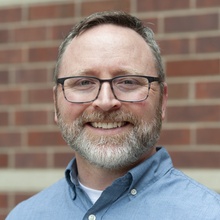By Izabela Zaluska
Two faculty members in the College of Liberal Arts and Sciences recently received grants from the Roy J. Carver Charitable Trust to further their research projects, which will in turn further the work in their respective fields.
Scott Daly, associate professor in the Department of Chemistry, received $373,254 to develop the chemistry to separate lanthanide isotopes in large quantities.
Katheryn Rothenberg, assistant professor in the Department of Biology, received $382,644 for work to explore the role of a particular protein—Rap1 GTPase—in controlling cell migration.
Learn more about their projects and what they enjoy most about their work.
Developing chemistry for large-scale separation of rare earth isotopes
Daly and his research group are inorganic chemists who specialize in the synthesis and design of metal-containing chemicals.

Daly, who joined the college in 2014, works with elements that span the entire periodic table, including elements at the bottom called lanthanides and actinides. These elements are important in strategic materials, nuclear fields, and medicine. Lanthanides are also referred to as rare earth elements.
There’s interest in using certain isotopes of these elements in medicine, particularly for cancer treatment. With the grant funded by the Roy J. Carver Charitable Trust, Daly and his team are developing the chemistry to separate these isotopes in large quantities. Currently, the method to separate lanthanides is done on very small scales, which comes with limitations, Daly added.
“We're designing chemicals that we think will allow us to separate lanthanide isotopes that are important for current and future radiopharmaceutical applications, including at the very large scales they’re needed to make an impact on the drug market,” Daly said.
Daly started preliminary research for this type of work in 2020 and can move forward with the project thanks to the grant dollars.
“We're so thankful to the Roy J. Carver Charitable Trust for giving us the opportunity to explore this chemistry and potentially address a very important problem,” Daly said.
Daly added that he feels supported by the college in this work and research, too. What he enjoys most about the environment in CLAS is working with students and being able to pursue his research ideas.
“Every day is a learning experience and to be able to work with the students and pass that knowledge around and share in the discoveries is, to me, the most rewarding and fulfilling part of this job,” Daly said.
Exploring role of Rap1 GTPase in controlling cell migration
Rothenberg’s research focuses on how cells can move together in groups. This is important because cells move together to create tissues and organs during embryonic development, as well as to heal cuts and wounds.
But sometimes cells moving together isn’t favorable, like when cancer cells metastasize.
“In my research group, we aim to understand how cells know when to start moving and how they communicate with each other to stay coordinated,” Rothenberg said. “If we know these fundamental mechanisms, we may be able to control cell movement—for example, to heal wounds faster or stop cancer metastasis.”
Rothenberg’s project funded by the Roy J. Carver Charitable Trust explores the role of a particular protein—Rap1 GTPase—in controlling cell migration. Her previous work has shown that when Rap1 is active, it helps cells move faster.
Rothenberg and her team are now investigating what proteins turn Rap1 “on” or “off” and how these proteins are regulated.
“We are also developing tools to observe and control Rap1 activity in real time,” Rothenberg said. “We hope to discover a way to carefully control Rap1 activity to affect cell movement.”
The grant dollars have allowed Rothenberg to hire a PhD student to work on the project full-time, as well as purchasing the necessary equipment and supplies for new experiments. A major part of the project, she said, is generating new tools to observe and control protein activity inside living cells.
“The design, construction, and implementation of these tools can be resource-intensive, but the final product is useful to not only our work but the work of others,” Rothenberg said. “This grant supports our research goals while helping advance the field as a whole.”
Rothenberg, who joined CLAS in August 2024, said the college has been very supportive as she’s started her work at the university, including providing initial funds to get her research lab set up.
One of her favorite aspects of being in CLAS and her research is working with students.
“I get to teach undergraduates about our work and see them grow as scientists and take on their own experiments, while also collaborating with graduate students to come up with new ideas or approaches,” Rothenberg said.